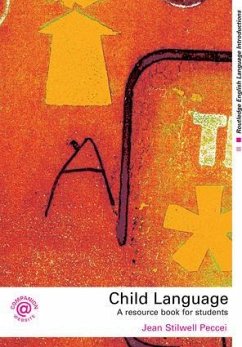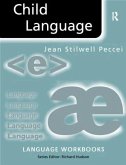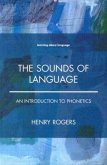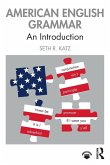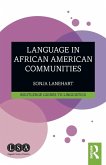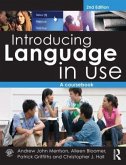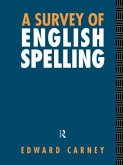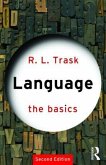Jean Stilwell Peccei (UK formerly at Roehampton University)
Child Language
A Resource Book for Students
Jean Stilwell Peccei (UK formerly at Roehampton University)
Child Language
A Resource Book for Students
- Broschiertes Buch
- Merkliste
- Auf die Merkliste
- Bewerten Bewerten
- Teilen
- Produkt teilen
- Produkterinnerung
- Produkterinnerung
Child Language provides a flexible, one-stop resource for both students and teachers in courses on children's language development.
Andere Kunden interessierten sich auch für
![Child Language Child Language]() Jean Stilwell PecceiChild Language37,99 €
Jean Stilwell PecceiChild Language37,99 €![The Sounds of Language The Sounds of Language]() Henry RogersThe Sounds of Language61,99 €
Henry RogersThe Sounds of Language61,99 €![American English Grammar American English Grammar]() Seth R. KatzAmerican English Grammar41,99 €
Seth R. KatzAmerican English Grammar41,99 €![Language in African American Communities Language in African American Communities]() Sonja Lanehart (USA University of Texas at San Antonio)Language in African American Communities35,99 €
Sonja Lanehart (USA University of Texas at San Antonio)Language in African American Communities35,99 €![Introducing Language in Use Introducing Language in Use]() Andrew John Merrison (UK York St John University)Introducing Language in Use99,99 €
Andrew John Merrison (UK York St John University)Introducing Language in Use99,99 €![A Survey of English Spelling A Survey of English Spelling]() Edward CarneyA Survey of English Spelling75,99 €
Edward CarneyA Survey of English Spelling75,99 €![Language Language]() R.L. TraskLanguage30,99 €
R.L. TraskLanguage30,99 €-
-
-
Child Language provides a flexible, one-stop resource for both students and teachers in courses on children's language development.
Produktdetails
- Produktdetails
- Routledge English Language Introductions
- Verlag: Taylor & Francis Ltd
- Seitenzahl: 210
- Erscheinungstermin: 13. Dezember 2005
- Englisch
- Abmessung: 246mm x 174mm x 12mm
- Gewicht: 376g
- ISBN-13: 9780415281034
- ISBN-10: 0415281032
- Artikelnr.: 21669969
- Herstellerkennzeichnung
- Libri GmbH
- Europaallee 1
- 36244 Bad Hersfeld
- gpsr@libri.de
- Routledge English Language Introductions
- Verlag: Taylor & Francis Ltd
- Seitenzahl: 210
- Erscheinungstermin: 13. Dezember 2005
- Englisch
- Abmessung: 246mm x 174mm x 12mm
- Gewicht: 376g
- ISBN-13: 9780415281034
- ISBN-10: 0415281032
- Artikelnr.: 21669969
- Herstellerkennzeichnung
- Libri GmbH
- Europaallee 1
- 36244 Bad Hersfeld
- gpsr@libri.de
Jean Stilwell Peccei is a Visiting Lecturer in the English Language & Linguistics programme at Roehampton University. She is the author of Child Language 2nd Edition (Routledge Language Workbooks series, 1999) and Pragmatics (Routledge Language Workbooks series, 1999) and co-author of Language, Society and Power 2nd Edition (Routledge 2004).
A. Introduction: Key Concepts in Language Acquisition A.1. Approaches to
Language Acquisition A.2. Phonological Development A.3. Lexical Development
A.4. Morphological Development A.5. Syntactic Development A.6. Discourse
Development A.7. Literacy Development A.8. The Bilingual Child B.
Development: Analyzing Children's Language B.1. A Closer Look at Child
Directed Speech B.2. Learning and Producing the Sounds of Words B.3.
Learning the Meaning of Words B.4. Learning How to Build Words B.5.
Learning How to Build Sentences B.6. Acquiring Communicative Competence
B.7. A Closer Look at Spelling B.8. Using Two Dialects C. Exploration: Data
for Investigation C.1. Research Methods C.2. Children's Pronunciation
Patterns C.3. Children's Lexicons C.4. Children as Word-makers C.5.
Building a Grammar C.6. Children's Conversations C.7. Children's Writing
C.8. Using More Than one Language D. Extension: Readings in Language
Acquisition D.1. Current Perspectives on Language Acquisition D.2.
Children's Mental Representations of Sounds D.3. Naming Things for Children
D.4. A Child's Invention of New Words D.5. Accounting for Growth and Change
in Children's Grammar D.6. Language and Socialization D.7. A
Cross-Linguistic Approach to Dyslexia D.8. Bilingual Children's Use of
Code-Switching. References. Glossarial Index
Language Acquisition A.2. Phonological Development A.3. Lexical Development
A.4. Morphological Development A.5. Syntactic Development A.6. Discourse
Development A.7. Literacy Development A.8. The Bilingual Child B.
Development: Analyzing Children's Language B.1. A Closer Look at Child
Directed Speech B.2. Learning and Producing the Sounds of Words B.3.
Learning the Meaning of Words B.4. Learning How to Build Words B.5.
Learning How to Build Sentences B.6. Acquiring Communicative Competence
B.7. A Closer Look at Spelling B.8. Using Two Dialects C. Exploration: Data
for Investigation C.1. Research Methods C.2. Children's Pronunciation
Patterns C.3. Children's Lexicons C.4. Children as Word-makers C.5.
Building a Grammar C.6. Children's Conversations C.7. Children's Writing
C.8. Using More Than one Language D. Extension: Readings in Language
Acquisition D.1. Current Perspectives on Language Acquisition D.2.
Children's Mental Representations of Sounds D.3. Naming Things for Children
D.4. A Child's Invention of New Words D.5. Accounting for Growth and Change
in Children's Grammar D.6. Language and Socialization D.7. A
Cross-Linguistic Approach to Dyslexia D.8. Bilingual Children's Use of
Code-Switching. References. Glossarial Index
A. Introduction: Key Concepts in Language Acquisition A.1. Approaches to
Language Acquisition A.2. Phonological Development A.3. Lexical Development
A.4. Morphological Development A.5. Syntactic Development A.6. Discourse
Development A.7. Literacy Development A.8. The Bilingual Child B.
Development: Analyzing Children's Language B.1. A Closer Look at Child
Directed Speech B.2. Learning and Producing the Sounds of Words B.3.
Learning the Meaning of Words B.4. Learning How to Build Words B.5.
Learning How to Build Sentences B.6. Acquiring Communicative Competence
B.7. A Closer Look at Spelling B.8. Using Two Dialects C. Exploration: Data
for Investigation C.1. Research Methods C.2. Children's Pronunciation
Patterns C.3. Children's Lexicons C.4. Children as Word-makers C.5.
Building a Grammar C.6. Children's Conversations C.7. Children's Writing
C.8. Using More Than one Language D. Extension: Readings in Language
Acquisition D.1. Current Perspectives on Language Acquisition D.2.
Children's Mental Representations of Sounds D.3. Naming Things for Children
D.4. A Child's Invention of New Words D.5. Accounting for Growth and Change
in Children's Grammar D.6. Language and Socialization D.7. A
Cross-Linguistic Approach to Dyslexia D.8. Bilingual Children's Use of
Code-Switching. References. Glossarial Index
Language Acquisition A.2. Phonological Development A.3. Lexical Development
A.4. Morphological Development A.5. Syntactic Development A.6. Discourse
Development A.7. Literacy Development A.8. The Bilingual Child B.
Development: Analyzing Children's Language B.1. A Closer Look at Child
Directed Speech B.2. Learning and Producing the Sounds of Words B.3.
Learning the Meaning of Words B.4. Learning How to Build Words B.5.
Learning How to Build Sentences B.6. Acquiring Communicative Competence
B.7. A Closer Look at Spelling B.8. Using Two Dialects C. Exploration: Data
for Investigation C.1. Research Methods C.2. Children's Pronunciation
Patterns C.3. Children's Lexicons C.4. Children as Word-makers C.5.
Building a Grammar C.6. Children's Conversations C.7. Children's Writing
C.8. Using More Than one Language D. Extension: Readings in Language
Acquisition D.1. Current Perspectives on Language Acquisition D.2.
Children's Mental Representations of Sounds D.3. Naming Things for Children
D.4. A Child's Invention of New Words D.5. Accounting for Growth and Change
in Children's Grammar D.6. Language and Socialization D.7. A
Cross-Linguistic Approach to Dyslexia D.8. Bilingual Children's Use of
Code-Switching. References. Glossarial Index

